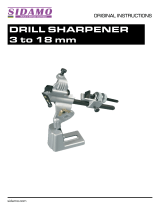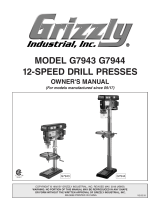Drill Master 500X Operating instructions
- Category
- Power tools
- Type
- Operating instructions
This manual is also suitable for
Drill Master 500X is a versatile and powerful drill sharpener designed to restore the sharpness of various drill bits, including high-speed steel, cobalt, parabolic, TiN coated, and solid carbide. With its standard diamond grinding wheel, it can sharpen three common drill bit types: standard 118°, high-performance split point 135°, and carbide 135° masonry bits. It features an alignment tube to ensure precise positioning of the drill bit, spring steel pawls to firmly hold the drill in place, and a loop handle for easy adjustment of the point angle.
Drill Master 500X is a versatile and powerful drill sharpener designed to restore the sharpness of various drill bits, including high-speed steel, cobalt, parabolic, TiN coated, and solid carbide. With its standard diamond grinding wheel, it can sharpen three common drill bit types: standard 118°, high-performance split point 135°, and carbide 135° masonry bits. It features an alignment tube to ensure precise positioning of the drill bit, spring steel pawls to firmly hold the drill in place, and a loop handle for easy adjustment of the point angle.












-
 1
1
-
 2
2
-
 3
3
-
 4
4
-
 5
5
-
 6
6
-
 7
7
-
 8
8
-
 9
9
-
 10
10
-
 11
11
-
 12
12
Drill Master 500X Operating instructions
- Category
- Power tools
- Type
- Operating instructions
- This manual is also suitable for
Drill Master 500X is a versatile and powerful drill sharpener designed to restore the sharpness of various drill bits, including high-speed steel, cobalt, parabolic, TiN coated, and solid carbide. With its standard diamond grinding wheel, it can sharpen three common drill bit types: standard 118°, high-performance split point 135°, and carbide 135° masonry bits. It features an alignment tube to ensure precise positioning of the drill bit, spring steel pawls to firmly hold the drill in place, and a loop handle for easy adjustment of the point angle.
Ask a question and I''ll find the answer in the document
Finding information in a document is now easier with AI
Related papers
Other documents
-
 QEP 62971 User guide
QEP 62971 User guide
-
Parkside PSS 65 C1 User manual
-
Lumberjack CBS45LS Owner's manual
-
DeWalt DW751 User manual
-
 SIDAMO A700000008501118 Drill Sharpener User manual
SIDAMO A700000008501118 Drill Sharpener User manual
-
Grizzly G0925 Owner's manual
-
Power Fist 8680282 Owner's manual
-
VEVOR MR-13B User manual
-
Wen BG4108 User manual
-
 Grizzly Industrial G7947 Owner's manual
Grizzly Industrial G7947 Owner's manual














